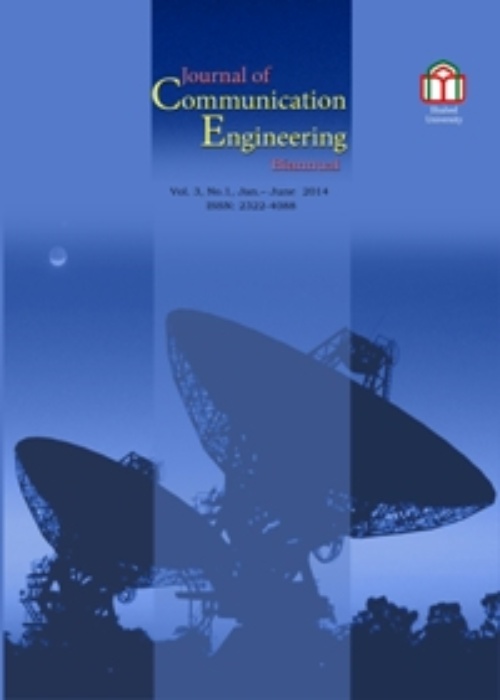فهرست مطالب

Journal of Communication Engineering
Volume:2 Issue: 3, Summer 2013
- تاریخ انتشار: 1392/08/23
- تعداد عناوین: 6
-
-
Pages 154-167Simultaneous estimation of range and angle of close emitters usually requires a multidimensional search. This paper offers an algorithm to improve the position of an element of any array designed on the basis of some certain or random rules. In the proposed method one element moves on its original direction, i.e., keeping the vertical distance to each source, to reach the constellation with less CRB. The performance of this method has been demonstrated through simulation and a comparison of the CRB with receptive signals covariance matrix determinant has been made before and after the use of this method.Keywords: Cramer, Rao Bound, Direction of Arrival, Range, Near, field
-
Pages 168-182In this study, we introduce a new two-way relay channel and obtain an inner bound and an outer bound for the discrete and memoryless multiple access relay channels with receiver-source feedback via two-way relay channel in which end nodes exchange signals by a relay node. And we extend these results to the Gaussian case. By numerical computing, we show that our inner bound is the same with one obtained by Hou-Koetter-Kramer, for the channel with relay-source feedback.Keywords: multiple access relay channel, two, way relay channel, block Markov coding
-
Pages 183-191This paper investigates the use of redundancy and self repairing against node failures in distributed storage systems using a novel non-MDS erasure code. In replication method, access to one replication node is adequate to reconstruct a lost node, while in MDS erasure coded systems which are optimal in terms of redundancy-reliability tradeoff, a single node failure is repaired after recovering the entire stored data, thereby consuming more repair bandwidth. The current paper aims at investigating a new type of erasure codes with a reduced repair bandwidth as compared to conventional MDS erasure codes. Specifically, we propose a non- MDS using the proposed code a single node failure can be repaired through connecting to only three nodes which gives the ability to reduce the repair bandwidth comparing to MDS codes. (2k; k) code that tolerates any three node failures and more importantly, it is shownKeywords: Distributed storage systems, Erasure code, MDS code
-
Pages 192-207The performance of Orthogonal Frequency Division Multiple Access (OFDMA) system degrades significantly in doubly dispersive channels. This is due to the fact that exponential sub-carriers do not match the singular functions of this type of channels. To solve this problem, we develop a system whose sub-carriers are chirp functions. This is equivalent to exploiting Fractional Fourier Transform (FrFT) instead of Fourier Transform (FT) in the structure of the aforementioned transmission scheme. We name the new system FrFT-OFDMA. The optimal angle of fractional Fourier transform for each user depends on its channel parameters. Thus, the angles of transform for different users are not necessarily identical. This destroys the orthogonality of users and generates Multi-User Interference (MUI). By analyzing MUI, we introduce quasi-orthogonality conditions where interference is negligible despite different angles of transform. For non-orthogonal users, we propose a method to mitigate MUI. We present the efficiency of this method through comparative performance evaluation of the conventional system based on FT and the new system based on FrFT. We show that our proposed transmission scheme outperforms the traditional OFDMA system significantly in doubly dispersive channels and channels impaired by frequency offset.Keywords: Doubly dispersive channels, Fractional Fourier transform, OFDMA
-
Pages 208-221In this paper, intelligent models based on fuzzy inference are proposed to analyze single overhead line terminated to arrester. This paper consists of two parts. The first one is modeling overhead line; and the second one is related to modeling grounding system. In each part, the behavior of the problem is first represented as simple and unchanged membership functions. After then, effects of parameters of the problem such as height of overhead line, and lightning-strike point are extracted as simple curves. As a result, these achieved models in despite of transmission line model (TLM) is applicable for high frequencies created by lightning strikes.Keywords: Overhead line, Arrester, Fuzzy inference
-
Pages 222-231This study describes a hybrid technique for identification of buried objects. The object’s shape and electromagnetic profile are reconstructed from evaluations of electrical permittivity and conductivity. The method suggests a combination of linear sampling and optimization. Linear sampling method (LSM) is used to recover shape and metaheuristic optimizations essential to reconstruct the inside profile. A special case of a non-homogenous object is considered. In this case the object is a buried homogenous dielectric for which the position and volume of the hole inside is not known. In this case, after recovering data by the same process used in the first step, it is necessary to recover the volume and position of the hole. This case will be useful when the final target of identification is an embedded object. The final results of this case verify the effectiveness and feasibility of the proposed method. Effectiveness of the method is validated by application of one real world cases involving civil engineering. In all cases presented in this study, the rates of final reconstruction error are acceptable and less than 10%. These results prove that this proposed procedure can be applied to reconstruct hollow objects correctly.Keywords: Inverse scattering, linear sampling method, Optimization, Profile reconstruction


